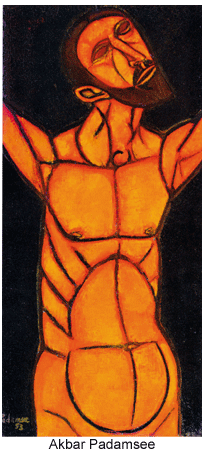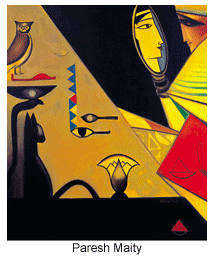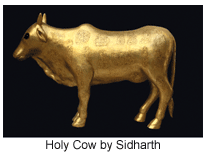- Ah, the heat
- Guest Editor’s Column
- Art Moderne: Art Deco Furniture
- Lithograph Tin Toys
- Film Memorabilia
- Creative Impulse
- Hard Talk
- Possibility of Democracy in China
- In the News
- Artist Index and Statistics
- Market Insight
- Auction Reports : What happened
- Auction Reports : what's forthcoming
- Art Bengaluru
- Art’s Eye-view
- The month that was
- Photo Feature
- Roerich bridges Indo-Russian Cultural Relations
- Image and Symbol: Painters' Perceptions
- Image and Symbol: Sculptors' Perceptions
- My Window Shut to Open
- Paramjit Singh
- Mrinalini Mukherjee
- The Spirit of A Butterfly
- Have I Ever Opposed You?
- S(outh) E(ast) A(sia)
- Splitting the Other
- The Things That Happen When Falling in Love
- Millijunction
- Terminology
- Know your Act
- Different hues of Aakriti
ART news & views
Art’s Eye-view
Volume: 2 Issue No: 3 Month: 4 Year: 2010
March of the auctions
 Never before were the ides of March such a clear indication of change. No longer is the art trade holding its breath as big-ticket sales have unshackled trade to what most perceive are 2006-07 levels. March is generally accepted to be auction heaven, when Indians who still plan the year according to its fiscal closing on March 31 find it possible to add a number before an alarming number of zeros to turn the whole biz of collecting art into a glut fest. And March 2010 has woken up a somnambulant market to add sizzle to it.
Never before were the ides of March such a clear indication of change. No longer is the art trade holding its breath as big-ticket sales have unshackled trade to what most perceive are 2006-07 levels. March is generally accepted to be auction heaven, when Indians who still plan the year according to its fiscal closing on March 31 find it possible to add a number before an alarming number of zeros to turn the whole biz of collecting art into a glut fest. And March 2010 has woken up a somnambulant market to add sizzle to it. Prices were expected to rise, but their strength has come as a surprise to most. Saffronart, which began the March auctions with fairly soft estimates, found the masters flying, with M F Husain leading the pack with an Untitled work selling for Rs 2.01 crore. The Osian's sale, which was next in Mumbai, created a stir when a Mahishasura triptych by Tyeb Mehta hinted at a very strong revival at Rs 4.5 crore.
But it was the two New York auctions that pulled out all stops with S. H Raza once again showing his domination of the market with a single work commanding Rs 5.6 crore, Husain matching Tyeb Mehta at Rs 4.5 crore, and Souza going for Rs 2.2 crore at Christie's. Sotheby's continued the run with Husain leading the race at Rs 4.86 crore, Manjit Bawa striking rich at Rs 2.77 crore, Tyeb Mehta fetching Rs 2.6 crore for one of his less inspired but early works, and two Razas scoring off with Rs 2.23 crore and Rs 1.77 crore respectively.
What was interesting was that antiquities at both auctions also commanded top-dollar prices, almost matching the gold rush of the modern masters. Clearly, it's India season out there, and after the low summer season, you can expect prices to harden again. The contemporaries, though, still need resuscitation.
Art of travel
 Paresh Maity's dialogue with his journeys took the form of a huge exhibition on places he has painted on his extensive travels, in India and outside. Taking note of his visual diary, the World Travel and Tourism Council (India) organised a seminar for its members at Rabindra Bhawan, amidst the exhibited works, on art and travel. Artists, it was agreed, have always been commentators on places and societies through their works, but there was the larger question that remained unanswered: who is going to ensure that busloads of tourists arrive at the Museum of Modern Art, at other art museums and galleries, to give visitors a fillip on modern and contemporary art in India?
Paresh Maity's dialogue with his journeys took the form of a huge exhibition on places he has painted on his extensive travels, in India and outside. Taking note of his visual diary, the World Travel and Tourism Council (India) organised a seminar for its members at Rabindra Bhawan, amidst the exhibited works, on art and travel. Artists, it was agreed, have always been commentators on places and societies through their works, but there was the larger question that remained unanswered: who is going to ensure that busloads of tourists arrive at the Museum of Modern Art, at other art museums and galleries, to give visitors a fillip on modern and contemporary art in India? Contemporary voices
If the first quarter is any indication, we aren't going to see too much work by way of the contemporaries. Sure, there have been shows by both Atul Dodiya and Anju Dodiya in Delhi, and Sunil Gawde wooed Mumbai, but contemporary artists doing and showing new work for solo shows is now becoming rarer. And when they do, (with exceptions) many of the contemporaries are showing earlier works instead of a new body of art.In part, this is because prices for the contemporary artists have still to recover, but it's also a Catch-22 situation: if you don't show, you don't gain. Still, galleries are wary of investing in younger, contemporary artists because collectors are treating them like the proverbial milk that scalded them when their values plummeted. That several galleries also suffered in the bargain and have all but disappeared in an indication that we might have to wait a while longer for the voices of this generation to be heard again. Others are betting on the rise of newer names at the cost of the current contemporary stalwarts. Sigh!
Holy cow
Sidharth has placed himself cleverly in a space that falls between artists who are seen as decorative and those who are seen to reflect on societal and current issues with his recent exhibition, The Laughing Cow. Using the bovine as his leitmotif, he has created a body of works on canvas and in mixed media that address concerns about the creature in our current obsession with ourselves and urban aspirations. It brings alive debates on consumption and exploitation and greed, on obfuscation of tradition for an acceptance of synthetic packaging and a loss of nature and natural habitats.
Using the bovine as his leitmotif, he has created a body of works on canvas and in mixed media that address concerns about the creature in our current obsession with ourselves and urban aspirations. It brings alive debates on consumption and exploitation and greed, on obfuscation of tradition for an acceptance of synthetic packaging and a loss of nature and natural habitats. But these debates and discussions don't dilute Sidharth's eye for detail and the flow of his lines and use of natural pigments and colours. Unlike his peers, he does not shock, so it is easy to live with the lyricism of his paintings. But already he's decided on his next body of work, which will raise many of the same issues, but allow him to lend a painterly quality to his subject: Water.
Celebrating the bindu
 S H Raza, meanwhile, is back in Paris after his India sojourn, on travels that took him to Indore, Kolkata, New Delhi… In the capital, he was felicitated on his 88th birthday with a show of his paintings, the French Ambassador released a set of his prints, there was a gallery show: as a visit, it went off without a hitch, unlike the previous time when he was confronted with a whole exhibition of fakes allegedly painted by him, which he inaugurated. This time he promises to be back in India on a permanent basis which, in the absence of Husain, would make him the country's senior-most artist-in-residence.
S H Raza, meanwhile, is back in Paris after his India sojourn, on travels that took him to Indore, Kolkata, New Delhi… In the capital, he was felicitated on his 88th birthday with a show of his paintings, the French Ambassador released a set of his prints, there was a gallery show: as a visit, it went off without a hitch, unlike the previous time when he was confronted with a whole exhibition of fakes allegedly painted by him, which he inaugurated. This time he promises to be back in India on a permanent basis which, in the absence of Husain, would make him the country's senior-most artist-in-residence.
Kishore Singh